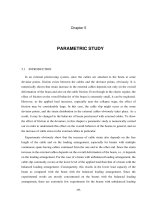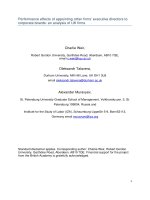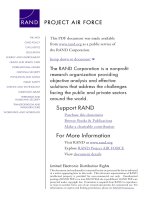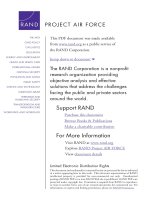Numerical analysis of quantum dots nanostructures
Bạn đang xem bản rút gọn của tài liệu. Xem và tải ngay bản đầy đủ của tài liệu tại đây (5.23 MB, 169 trang )
NUMERICAL SIMULATION OF QUANTUM DOT
NANOSTRUCTURES
QUEK SIU SIN JERRY
(B.Eng. (Hons.), NUS)
A THESIS SUBMITTED
FOR THE DEGREE OF DOCTORATE OF PHILOSOPHY
DEPARTMENT OF MECHANICAL ENGINEERING
NATIONAL UNIVERSITY OF SINGAPORE
2003
Ph. D. Dissertation
⋅
Quek Siu Sin Jerry Acknowledgements
ACKNOWLEDGEMENTS
1. A/Prof. Liu Gui Rong (Supervisor) – for his supervision, guidance and many
valuable advice. And for the many learning opportunities given throughout
the years.
2. Dr. Han Xu (Manager, Centre for ACES) – for his support while working in
the Centre for ACES.
3. Various staff and graduate students of Centre for ACES – for sharing their
ideas and knowledge.
4. Staff of NUS IT Unit, CALES 1 – for their support in providing the computing
resources.
Ph. D. Dissertation
⋅
Quek Siu Sin Jerry Contents
CONTENTS
SUMMARY i
LIST OF SYMBOLS iii
LIST OF FIGURES v
LIST OF TABLES xi
1 INTRODUCTION 1
1.1. Literature Review 4
1.1.1. Development of Quantum Dots in Brief 4
1.1.2. Fabrication Techniques for Quantum Dots 8
1.1.3. Characterization of Quantum Dots 11
1.1.4. Self-organized Ordering of Quantum Dot Superlattices 13
1.1.5. Modeling and Simulation of Quantum Dot Heterostructure 15
2 FINITE ELEMENT FORMULATION FOR ANALYSIS OF QUANTUM DOT
HETEROSTRUCTURES 20
2.1. The SK Growth Mode, Stress Relaxation and Vertical Correlation 20
2.2. Finite Element Modeling 22
2.2.1. 2D Axi-symmetric Model 24
2.2.2. 3D Model 32
2.3. Strain Energy Density Calculation 38
3. NUMERICAL FORMULATION OF QUANTUM DOT SURFACE
EVOLUTION 40
3.1. Surface Roughening 40
Ph. D. Dissertation
⋅
Quek Siu Sin Jerry Contents
3.1.1. Moving Least Squares (MLS) Interpolation 42
3.1.2. Surface Displacement Time Marching 44
4. FINITE ELEMENT NUMERICAL SIMULATIONS OF QUANTUM DOT
HETEROSTRUCTURE 50
4.1. 2D Axi-symmetric Finite Element Model 51
4.1.1. Model Parameters 51
4.1.2. Results and Discussions 52
4.2. 3D Finite Element Model 62
4.2.1. Model Parameters 62
4.2.2. Results and Discussions 64
4.3. Effects of Elastic Anisotropy on the Self Organized Ordering of Quantum
Dots 74
4.3.1. Model Parameters 74
4.3.2. Results and Discussions 77
5. NUMERICAL SIMULATION OF QUANTUM DOT SURFACE EVOLUTION. 94
5.1. 2D Quantum Dot Island Growth 94
5.2. Note on Sensitivity of Time Step Used 101
5.3. 3D Quantum Dot Island Growth 103
5.3.1. Growth of CdSe Quantum Dots on ZnSe(001) 106
5.3.2. Growth of CdSe Quantum Dots on ZnSe(111) 117
6. CONCLUSION 123
REFERENCES 130
Ph. D. Dissertation
⋅
Quek Siu Sin Jerry Contents
APPENDIX A A-1
APPENDIX B B-1
APPENDIX C C-1
Ph. D. Dissertation
⋅
Quek Siu Sin Jerry Summary
i
SUMMARY
Nanotechonology is the key to future’s technology and while researchers build
devices and novel materials at the nanoscale, the one major obstacle is the efficient
mass-production of these nano-materials that have sizes of just a few atoms. A
particularly successful and interesting technique being used in recent years is by self-
assembly. Based on theories of lattice mismatch, coherent islands can be formed via
self-assembly that are small enough for size-quantization effects to be noticed. Such
islands are often called quantum dots and they possess interesting opto-electronic
properties with potential for novel device applications.
The numerical simulation of quantum dot nanostructures is presented in this thesis.
The finite element method is used to analyze the stress and strain fields in the
quantum dot heterostructure. The stress fields play a very important role in the lattice
arrangement of the heterostructures when quantum dot superlattice is fabricated.
Furthermore, the elastostatic fields in the quantum dot heterostructure are vital for
determining the opto-electronic properties of these structures. The finite element
model used consists of a pseudo thermal expansion of the buried quantum dot and the
wetting layer so as to simulate the mismatch strain caused by the difference in the
lattice parameters of the dissimilar semiconductor materials. A tied contact condition
is also modeled at the interface of the dissimilar materials, which basically ties the
nodes belonging to the island to the matrix.
Using results obtained from the finite element method, the strain energy density of a
new wetting layer surface can be calculated. The strain energy density is a major
Ph. D. Dissertation
⋅
Quek Siu Sin Jerry Summary
ii
contributor to the surface chemical potential and by analyzing the distribution, one
can predict the preferential site whereby new quantum dot(s) will be formed on the
surface. It is shown that consideration of elastic anisotropy of the semiconductor
materials has a significant effect on the vertical and lateral correlation of quantum
dots in the heterostructure. Various parameters like the variation in the thickness of
the cap layer was also shown to affect the correlation. The author hypothesized that at
small cap layer thickness, quantum dot islands will tend to coalesce directly above the
buried island. When the thickness of the cap layer increases, the islands separate and
move further away from the vertically correlated position.
The author also developed a code to simulate the surface evolution of the quantum
dot-growing layer. A mesh-free approach is employed by using the moving least
squares (MLS) interpolation method together with a forward marching finite
difference method. This method provides the approximation for solving the surface
diffusion equation typical of most epitaxy processes. The normal surface velocity and
hence the displacements can be deduced from the surface flux. The problem then
becomes an initial-value problem and is then marched forward in time using a
forward marching finite difference method. This method will enable analysts to
simulate real-time quantum dot formation and therefore able to predict the island
shape, size and vertical and lateral ordering.
Ph. D. Dissertation
⋅
Quek Siu Sin Jerry List of Symbols
iii
LIST OF SYMBOLS
ε
Strain
Ω Atomic volume
δ
Number of atoms per unit area
υ
Poisson’s ratio
σ
Stress
µ
Surface chemical potential
κ
Surface curvature
γ
Surface energy
µ
o
Initial bulk chemical potential
ε
o
Lattice mismatch strain
σ
o
Lattice mismatch stress
ε
T
Thermal strain
α
T
Thermal expansion coefficient
A Anisotropic ratio
a
i
Lattice parameter of island material
a
m
Lattice parameter of matrix material
c
ij
Components of material elastic matrix, c
D Surface diffusivity
D
m
Dissipating function
E Young’s modulus
f Global force vector
f
e
Element force vector
G Shear modulus
Ph. D. Dissertation
⋅
Quek Siu Sin Jerry List of Symbols
iv
H Cap layer thickness
h
i
Quantum dot island height
h
w
Wetting layer thickness
J
v
Surface flux
k Global stiffness matrix
k
B
Boltzmann constant
k
e
Element stiffness matrix
N
i
Finite element shape functions
q
i
Generalized displacements
T
Temperature
t
Time
T
K
Kinetic energy
U
Strain energy density
U
e
Strain energy
U
h
Approximation of global variables/generalized displacements
u
i
x
displacement component of node
i
U
o
Initial strain energy density
v
i
y
displacement component of node
i
v
n
Surface normal velocity
w(r)
Weight function
w
i
z
displacement component of node
i
Ph. D. Dissertation
⋅
Quek Siu Sin Jerry List of Figures
v
LIST OF FIGURES
Figure 1.1 Nature of electronic states in bulk material, quantum wells and quantum
dots. Top row: schematic morphology, bottom row: density of electronic states.
4
Figure 1.2 Schematic representation of different nanostructures fabrication
processes 7
Figure 2.1 Schematic diagram of epitaxial strain relaxation via island formation 21
Figure 2.2 Schematic representation of basic unit of quantum dot heterostructure 25
Figure 2.3 Geometry for 2D axi-symmetric finite element analysis 26
Figure 2.4 2D axi-symmetric finite element mesh 27
Figure 2.5 Tied contact in abaqus 31
Figure 2.6 3D finite element quarter model of heterostructure 33
Figure 2.7 3D finite element model of heterostructure with part of cap layer cut
away to reveal the pyramidal shaped quantum dot 35
Figure 3.1 Schematic of surface re-construction by adding blocks to an initially
planar surface 45
Figure 3.2 Flow chart of quantum dot surface evolution numerical procedure 49
Figure 4.1 2D stress (
σ
xx
) distribution of matrix in the x direction (h
i
= 3nm, H =
5nm) 53
Figure 4.2 2D stress (
σ
xx
) distribution of island in the x direction (h
i
= 3nm, H =
5nm) 53
Figure 4.3 Strain (
ε
xx
) distribution through centre of heterostructure model (h
i
=
3nm, H = 5nm) 56
Ph. D. Dissertation
⋅
Quek Siu Sin Jerry List of Figures
vi
Figure 4.4 Strain (
ε
zz
) distribution through centre of heterostructure model (h
i
= 3nm,
H = 5nm) 56
Figure 4.5 Stress (
σ
xx
) distribution on top surface of heterostructure (h
i
= 3nm, H =
5nm) 57
Figure 4.6 Stress (
σ
xx
) distribution on top surface of heterostructure with different
island heights (H = 30nm) 59
Figure 4.7 Stress (
σ
xx
) distribution on top surface of heterostructure with different
cap layer thickness (h
i
= 3nm) 60
Figure 4.8 Strain energy density distribution of top surface wetting layer before
island formation 62
Figure 4.9 3D stress (
σ
xx
) distribution of matrix in the y=0nm plane 64
Figure 4.10 3D stress (
σ
xx
) distribution of island in the y=0nm plane 65
Figure 4.11 Stress (
σ
xx
) distribution on top surface of heterostructure in the y=0nm
plane obtained using 2d and 3d models 66
Figure 4.12 3D stress (
σ
xx
) distribution of matrix in the y=6nm plane 66
Figure 4.13 3D stress (
σ
xx
) distribution of matrix in the
θ
= 45° plane (where
θ
is
measured in counter clockwise from the y = 0nm plane) 67
Figure 4.14 3D stress (
σ
xx
) distribution of island in the
θ
= 45° plane (where
θ
is
measured in counter clockwise from the y = 0nm plane) 67
Figure 4.15 Hydrostatic strain on the top surface of cap layer using a 3D quarter
model with isotropic material properties 68
Figure 4.16 3D mesh of heterostructure with truncated pyramidal shaped island 70
Figure 4.17 Stress (
σ
xx
) distribution of matrix in the plane of y = 0nm of
heterostructure with truncated pyramid island 71
Ph. D. Dissertation
⋅
Quek Siu Sin Jerry List of Figures
vii
Figure 4.18 Stress (
σ
xx
) distribution of island in the plane of y = 0nm of
heterostructure with truncated pyramid island 72
Figure 4.19 Comparison of stress (
σ
xx
) on top surface of cap layer (y = 0) of
heterostructures with truncated and full pyramid 73
Figure 4.20 Comparison of strain (
ε
xx
) through centre of truncated and full
pyramidal islands 73
Figure 4.21 Finite element model of basic unit of quantum dot heterostructure with
part of the cap layer cut away to reveal the pyramidal shaped island 75
Figure 4.22 Strain energy density distribution of top surface of second CdSe wetting
layer with the dimensionless spacer thickness, H/h
i
= 4; island base is 20 x 20
nm; h
i
= 10 nm; crystal orientation of [001] for the normal of the top surface of
the substrate and spacer-layer 78
Figure 4.23 Fringe plots of strain energy density of top surface of second CdSe
wetting layer with spacer-layer thickness of (a)H/h
i
= 2; (b) H/h
i
= 3; and (c)
H/h
i
= 4 79
Figure 4.24 Detailed fringe plot of the center region of top surface of second CdSe
wetting layer with spacer-layer thickness of H/h
i
= 3 80
Figure 4.25 Schematic diagram of spatial correlation of multiple layers of
CdSe/ZnSe(001) quantum dot structure in a tetragonal body centered
arrangement 82
Figure 4.26 Fringe plots of strain energy density of top surface of second InAs
wetting layer with spacer-layer thickness of (a)H/h
i
= 2; (b) H/h
i
= 3; and (c)
H/h
i
= 4 84
Figure 4.27 Strain energy density distribution of top surface of second CdSe wetting
layer with the dimensionless spacer thickness, H/h
i
= 4; island base is 20 x 20
Ph. D. Dissertation
⋅
Quek Siu Sin Jerry List of Figures
viii
nm; h
i
= 10 nm; crystal orientation of [111] for the normal of the top surface of
the substrate and spacer-layer 85
Figure 4.28 Position and depth of minima with various spacer-layer thickness of
CdSe/ZnSe(111) 86
Figure 4.29 Schematic diagram of spatial correlation of multiple layers of
CdSe/ZnSe(111) quantum dot structure with the quantum dots displaced from
the center in the [1-10] direction 87
Figure 4.30 Strain energy density distribution of top surface of second CdSe wetting
layer with the dimensionless spacer thickness, H/h
i
= 4 island base is 20 x 20
nm; h
i
= 10 nm; crystal orientation of [113] for the normal of the top surface of
the substrate and spacer-layer 88
Figure 4.31 Schematic diagram of spatial correlation of multiple layers of
CdSe/ZnSe(113) quantum dot structure with the quantum dots displaced from
the center in the [-3-32] direction 89
Figure 4.32 3D mesh of heterostructure with cuboid shaped island 90
Figure 4.33 Surface strain energy distribution of CdSe/ZnSe(001) of various H/h
i
obtained using a (a) pyramidal island and (b) cuboidal island 91
Figure 4.34 Strain energy density distribution of top surface of second CdSe wetting
layer with the dimensionless spacer thickness, H/h
i
= 4; cuboid shaped island of
dimensions 20 x 20 x 10 nm; crystal orientation of [001] for the normal of the
top surface of the substrate and spacer-layer 92
Figure 4.35 Schematic illustration showing decay of strain field above the (a)
pyramidal island and (b) cuboidal island 93
Figure 5.1 Schematic model for the simulation of the kinetic growth of the quantum
dot layer 95
Ph. D. Dissertation
⋅
Quek Siu Sin Jerry List of Figures
ix
Figure 5.2 2D growth of quantum dot wetting layer from t=0.01s to t=1s at time
steps of ∆t=0.01s 96
Figure 5.3 2D strain energy density distribution of wetting layer from t=0s to t=1s at
time steps of ∆t=0.01s 98
Figure 5.4 2D chemical potential per unit volume (
µ
/
Ω
) distribution of wetting
layer from t=0s to t=1s at time steps of ∆t=0.01s 99
Figure 5.5 2D quantum dot growth state at various cut-off times 100
Figure 5.6 Surface chemical potential at t = 2.0s 101
Figure 5.7 Unstable 2D simulation from t=0.02s to t=1s at time steps of ∆t=0.02s 103
Figure 5.8 Initial nodal distribution on surface of growing quantum dot layer 104
Figure 5.9 Gauss points distribution after applying mls interpolation 105
Figure 5.10 3D quantum dot growth state of CdSe/ZnSe(001) with H/h
i
= 2 at
various cut-off times 107
Figure 5.11 Plot of island height with different growth times for CdSe/ZnSe(001);
H = 20nm 108
Figure 5.12 Chemical potential distribution on surface of CdSe/ZnSe(001), H/h
i
= 2;
(a) t = 0.5s; (b) t = 5.0s 109
Figure 5.13 Strain energy density distribution on surface of CdSe/ZnSe(001), H/h
i
=
2; (a) t = 0.5s; (b) t = 5.0s 110
Figure 5.14 3D quantum dot growth state of CdSe/ZnSe(001) with H/h
i
= 3 at
various cut-off times 112
Figure 5.15 Contour plot of surface displacement of CdSe/ZnSe(001) with H/h
i
= 3
and t = 1s 113
Figure 5.16 Contour plot of surface displacement of CdSe/ZnSe(001) with H/h
i
= 3
and t = 5s 114
Ph. D. Dissertation
⋅
Quek Siu Sin Jerry List of Figures
x
Figure 5.17 3D quantum dot growth state of CdSe/ZnSe(001) with H/h
i
= 4 at
various cut-off times 115
Figure 5.18 Contour plot of normal surface displacement at t = 1s and H = 40nm 116
Figure 5.19 Surface profile of CdSe/ZnSe(111) with H = 20nm at various cut-off
times 118
Figure 5.20 Plot of island height with different growth times for CdSe/ZnSe(111);
H = 20nm 119
Figure 5.21 Contour plot of surface displacement of CdSe/ZnSe(111) (H/h
i
= 2 and
t = 1s) 120
Figure 5.22 Contour plot of surface displacement of CdSe/ZnSe(111) (H/h
i
= 4 and
t = 1s) 121
Figure 5.23 Surface profile of CdSe/ZnSe(113) with H = 40nm at t = 1s 122
Ph. D. Dissertation
⋅
Quek Siu Sin Jerry List of Tables
xi
LIST OF TABLES
Table 4.1 Geometric parameters for 2D FE model 51
Table 4.2 Isotropic elastic properties of InAs and GaAs 52
Table 4.3 Lattice parameters of various semiconductor materials 54
Table 4.4 Anisotropic elastic constants for various semiconductor materials 63
Table 4.5 Distance of strain energy density minimas from center of wetting layer
with various spacer-layer thicknesses and the crystallographic directions of
where the minimas are formed 81
Table 5.1 Model parameters for growth simulation of quantum dot layer 96
Ph.D. Dissertation · Quek Siu Sin Jerry Chapter 1
1
1 INTRODUCTION
This project involves the numerical computation of various aspects of quantum dot
nanostructures formation. Quantum dots can be considered to be clusters of atoms in the
nano-meter scale usually made up of semiconducting materials like Silicon (Si),
Germanium (Ge), Indium Arsenide (InAs), Gallium Arsenide (GaAs) and so on.
Quantum dots are attracting much interest because of their unique electro-optic properties
making them desirable for use in novel semiconductor and electronic devices.
Being in the order of nanometer in size, quantum dots are significantly smaller than the
micro-sized structures typical of current microelectronic circuits. Hence they are difficult
to manufacture using standard lithographic techniques and therefore, various alternative
methods are actually devised to produce them. Recently, a particularly interesting and
effective method is to grow the dots directly by depositing a thin film layer of material on
a substrate under appropriate growth conditions. More often than not, the depositing
material is different from the substrate material and hence, such structures are also known
generally as heterostructures. Due to the different lattice parameters between the
depositing and substrate material, lattice mismatched strain occurs and the thin layer
deposited on the substrate will break up into coherently strained islands. Such a growth
mode is typically known as the Stranski-Krastanow (SK) growth mode. The driving
force behind the SK growth mode is because of the strain energy stored in the lattice
mismatched, epitaxial thin film layer, making it generally unstable. Although
considerable research has been put into understanding this self-assembly of quantum dot
Ph.D. Dissertation · Quek Siu Sin Jerry Chapter 1
2
structures, there are still many ambiguities in the actual growth process. For example,
there still exist a debate if this quantum dot growth should be explained from a kinetic or
energetics point of view. This leads to the motivation behind using computational
simulation to analyze certain aspects of the quantum dot and thus gain a better
understanding of the process.
If one considers just the growth of a single epitaxial layer of quantum dots on the
substrate, the positions of growth as well as the size of the quantum dots can be said to be
highly statistical in nature. Without a regular arrangement of uniformly sized quantum
dots, the advantage of the discrete energy level the dots possessed cannot be utilized to its
full potential. To achieve better dot size and arrangement uniformity, the solution is to
grow multiple layers of the heterostructure to form quantum dot superlattices. It has been
found that the elastic fields induced by quantum dots in a bottom layer will assert a strong
influence on the ordering and possibly the size of quantum dots grown on a subsequent
layer. Therefore, this presents a tool for which one can tune the regular ordering and the
size of quantum dot superlattices. In this project, the author has used the finite element
method to investigate this elastic interaction of the buried quantum dots and its
subsequent quantum dots growth layer. Anisotropic material properties as well as
different crystal orientation of the materials were included in the analysis and interesting
results were obtained.
Other than using the finite element method to model the elastostatic effects of the
quantum dot nanostructures, the morphology of the quantum dot island was also analyzed.
Ph.D. Dissertation · Quek Siu Sin Jerry Chapter 1
3
Epitaxy can be considered as governed by surface diffusion of the adatoms involved.
Therefore, in analyzing the quantum dot island morphology, the surface diffusion
equation is solved which basically describes the movement of atoms or material from a
region of higher chemical potential to a region of lower potential. The numerical
approach employed is a meshless one utilizing the Moving Least Squares (MLS)
interpolation method together with a forward-marching finite difference method. By
using this numerical method, the evolution of the quantum dot island with respect to time
can be studied which further enhances the understanding of the spatial distribution, shape
and size of quantum dots.
This thesis consists of first a literature review of the various developments in the field of
quantum dot nanostructures as well as a review of computational methods typically used
in the numerical simulation of such structures. Following that, physical and
mathematical theories of quantum dot island formation as well as the numerical
approaches will be detailed. This will be followed by a detailed description of the
elastostatic analysis of quantum dot heterostructure. The finite element models used
consist of both two-dimensional (2D) and three-dimensional (3D) models. Both isotropic
material properties as well as anisotropic material properties will also be presented and
compared. Different parameters that affect the stress and strain fields will also be
presented. Then, a detailed presentation of the MLS approximation approach of solving
for the quantum dot island morphology will be given.
Ph.D. Dissertation · Quek Siu Sin Jerry Chapter 1
4
1.1. Literature Review
1.1.1. Development of Quantum Dots in Brief
Quantum dots are desirable for use in novel semiconductor and electronic devices
because of their interesting electro-optic properties. This is due to carrier localization in
all three dimensions resulting in the density of electronic states of quantum dots
becoming discrete as shown in Figure 1.1.
E
D
(E)
E
D
(E)
E
D
(E)
E
c
E
c
E
c
B
u
lk
Film (Quantum well)
Quantum dot
Figure 1.1 Nature of electronic states in bulk material, quantum wells and quantum dots.
Top row: schematic morphology, bottom row: density of electronic states against energy
of electronic states.
When the carrier motion in a solid is limited in layer of a thickness of the order of the
carrier de Broglie wavelength (or the mean free pass if this number is smaller), the effects
Ph.D. Dissertation · Quek Siu Sin Jerry Chapter 1
5
of size quantization will be observed. The de Broglie wavelength
λ
, depends on the
effective mass m
eff
of the carrier and on temperature T:
3
eff B
hh
p
mkT
λ
==
( 1.1 )
where h is the Planck’s constant, p is the momentum and k
B
is the Boltzman’s constant.
The mass of the charged carrier in Eq. ( 1.1 ) is not the free electron mass but the
effective mass of the electron (or hole) in the crystal. As this mass can be much smaller
than the free electron mass, size quantization effects can already be pronounced at a
thickness ten to a hundred times larger than the lattice constant. The introductory chapter
in the book by Bimberg et al (1999) gave a very concise historical development of
quantum dot heterostructures and a brief summary will be presented here. By the late
1950s and early 1960s there is already the idea of using ultra-thin layers for studies of
size quantization effects. At that time, the research focus was on thin films of semimetals
on mica substrates obtained by vacuum deposition. Nevertheless, thin films of
semiconductors and metals were also studied. At that time, the effect of increase in the
effective bandgap with decreasing film thickness was demonstrated. Though at that time,
theoretical works were highly recognized, the experimental studies were limited by the
inadequacy in technology.
With the advancement in technology and the development of novel deposition techniques
like molecular beam epitaxy and metal organic chemical vapor deposition in the late
1960s, the revolution started. It became possible to insert coherent layers a few lattice
constants thick, of a semiconductor of lower bandgap in a matrix with a larger bandgap,
restricting carrier movement to only two dimensions. In 1969-70, the use of multilayer
Ph.D. Dissertation · Quek Siu Sin Jerry Chapter 1
6
periodic semiconductor heterostructures (superlattices) for the creation of artificial
materials with controlled width of minizones for carrier transport along the superlattice
axis was proposed. The first superlattices of the GaP
0.3
As
0.7
/GaAs material system was
grown at around 1971. A clear demonstration of size quantization effects became
possible only after lattice-matched GaAs/AlGaAs structures with planar interfaces were
realized by molecular beam epitaxy. Researchers at that time also observed the effect of
resonant tunneling, proving the application of quantum mechanics to describe transport
phenomena in ultra-thin semiconductor heterostructures. Interesting results were
obtained from the optical studies of quantum wells and superlattices. For example, the
step-like characteristics of the absorption spectrum related to the two-dimensional
character of the density of states in quantum wells (Figure 1.1) were observed.
By the end of late 1980s, researchers have gained considerable understanding of quantum
wells and superlattices and naturally, interests shift towards structures with further
reduced dimensionality – to quantum wires (Kapon et al, 1989) and quantum dots. A
complete reduction of the remaining infinite extension of a quantum well in two
dimensions to atomic values lead to carrier localization in all three dimensions and
breakdown of classical band structure energy level model. The resulting energy level
structure of quantum dots is discrete (Figure 1.1), like in atomic physics, and many of the
physical properties of quantum dots resemble that of an atom in a cage. The study of
single quantum dots and ensembles of quantum dots presents a new chapter in
fundamental physics. A typical size of such a dot is 10nm and it may contain 10
4
or more
atoms.
Ph.D. Dissertation · Quek Siu Sin Jerry Chapter 1
7
Of course, having discovered and understood all these theories, to fabricate and make use
of quantum dots for device fabrication is not an easy task. The first realization of
quantum dots went as far back as the 1930s with nano-size semiconductor inclusions in
glass as shown in the schematic diagram in Figure 1.2(a). It was not until 1984, when
quantum confinement effects in such a system is confirmed experimentally. Many
approaches have been developed to fabricate quantum dots including artificial patterning
of thin layer structures into three-dimensional regions (Figure 1.2(b)).
CdS
Molten silicate
•
•
•
•
•
•
~8nm
AlGaAs
GaAs
AlGaAs
In
As
2
InAs
(a)
(b)
(c)
Figure 1.2 Schematic representation of different nanostructures fabrication processes
Ph.D. Dissertation · Quek Siu Sin Jerry Chapter 1
8
In the last decade however, greater success have been achieved using self-assembly
effects like that during the growth of strained heterostructures as shown schematically in
Figure 1.2(c). The best thing about this self-assembly process is that the fabrication
process is compatible with present optoelectronic device technology. With the discovery
of this process, the advancement in quantum dot nanotechnology took a huge leap ahead
and much research work were, and still being carried out on various semiconductor
systems. Much of the research work in this dissertation is based on understanding and
analyzing this self-assembly process using numerical simulation.
1.1.2. Fabrication Techniques for Quantum Dots
Lithographic Techniques
By the end of the 1980s, the most straightforward method of fabricating quantum dots
was by the patterning of quantum wells. This technique has several advantages, which
till today still attracts considerable attention. Firstly, quantum dots of arbitrary lateral
shape, size and arrangement can be realized depending on the resolution of the particular
lithographic technique used. Secondly, a variety of processing techniques are at the
researcher’s disposal. And finally, the technique is generally compatible with modern
VLSI (very large scale integrated) semiconductor technology. Lithographic techniques
comprise of (Beaumount, 1991; Sotomayor Torres
et al, 1994):
• optical lithography and holography,
Ph.D. Dissertation · Quek Siu Sin Jerry Chapter 1
9
• X-ray lithography,
• electron and focused ion beam lithography,
• scanning tunneling microscopy.
To the best of the author’s knowledge, the resolution of optical lithography based
methods is generally insufficient to fabricate structures of lateral dimensions of 20nm or
less. A maximum size of
≈20nm is required for the carriers to be sufficiently contained
at room temperature in typical semiconductors. Having said that, optical lithography
could nevertheless be used for fabrication of structures investigated at low temperatures
whereby confinement is easily reached and also for the fabrication of patterned substrates
that can be used subsequently by other techniques.
X-ray lithography (Warren
et al, 1986) has the advantage of much shorter wavelengths
and can be used for nanostructures fabrication effectively. However, an additional
process is required to fabricate the mask. Nevertheless, X-ray lithography has the
potential for mass production of nanoscale structures.
The most developed techniques for patterning quantum wells are electron beam
lithography (Howard
et al, 1985; Beaumount, 1991), focused ion beam lithography
(Komuro
et al, 1983), and also contact imprinting (Krauss, 1997). In electron beam
lithography (EBL), the electron beam is usually emitted from a high-brightness cathode
or a field emission gun and focused on the substrate by a multilens system. Resolution in
the 10-20nm range was demonstrated at the beginnings of the 1980s (Craighead
et al,









